Managerial Practice and Theory: A Project Management Internship Report
VerifiedAdded on 2023/06/18
|12
|4224
|81
Report
AI Summary
This report reflects on a project management internship experience in the UK, focusing on the development of skills and knowledge related to managerial practice and theory. It highlights the importance of leadership and change management in achieving organizational goals and gaining a competitive edge. The report discusses leadership theories such as servant leadership and ethical leadership, emphasizing the need for leaders to engage others, foster creativity, and demonstrate moral principles. It also explores problem-solving theory, outlining the steps involved in identifying and addressing challenges effectively. Through practical experiences, the internship provided insights into teamwork, professionalism, and the application of theoretical concepts in a real-world setting. The report concludes by emphasizing the value of leadership and problem-solving skills in future professional endeavors, with Desklib offering additional resources for students seeking similar solved assignments and study materials.
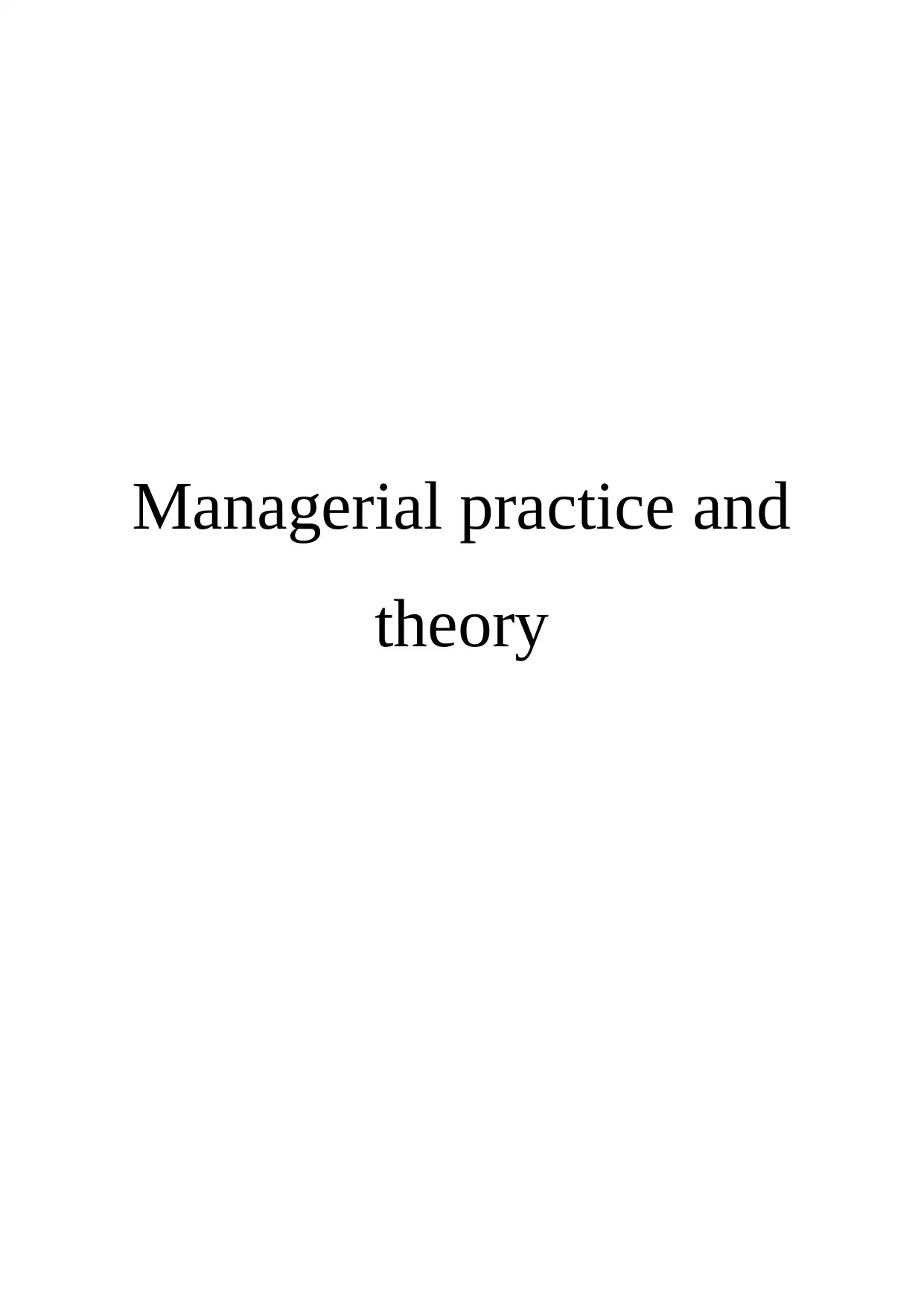
Managerial practice and
theory
theory
Paraphrase This Document
Need a fresh take? Get an instant paraphrase of this document with our AI Paraphraser
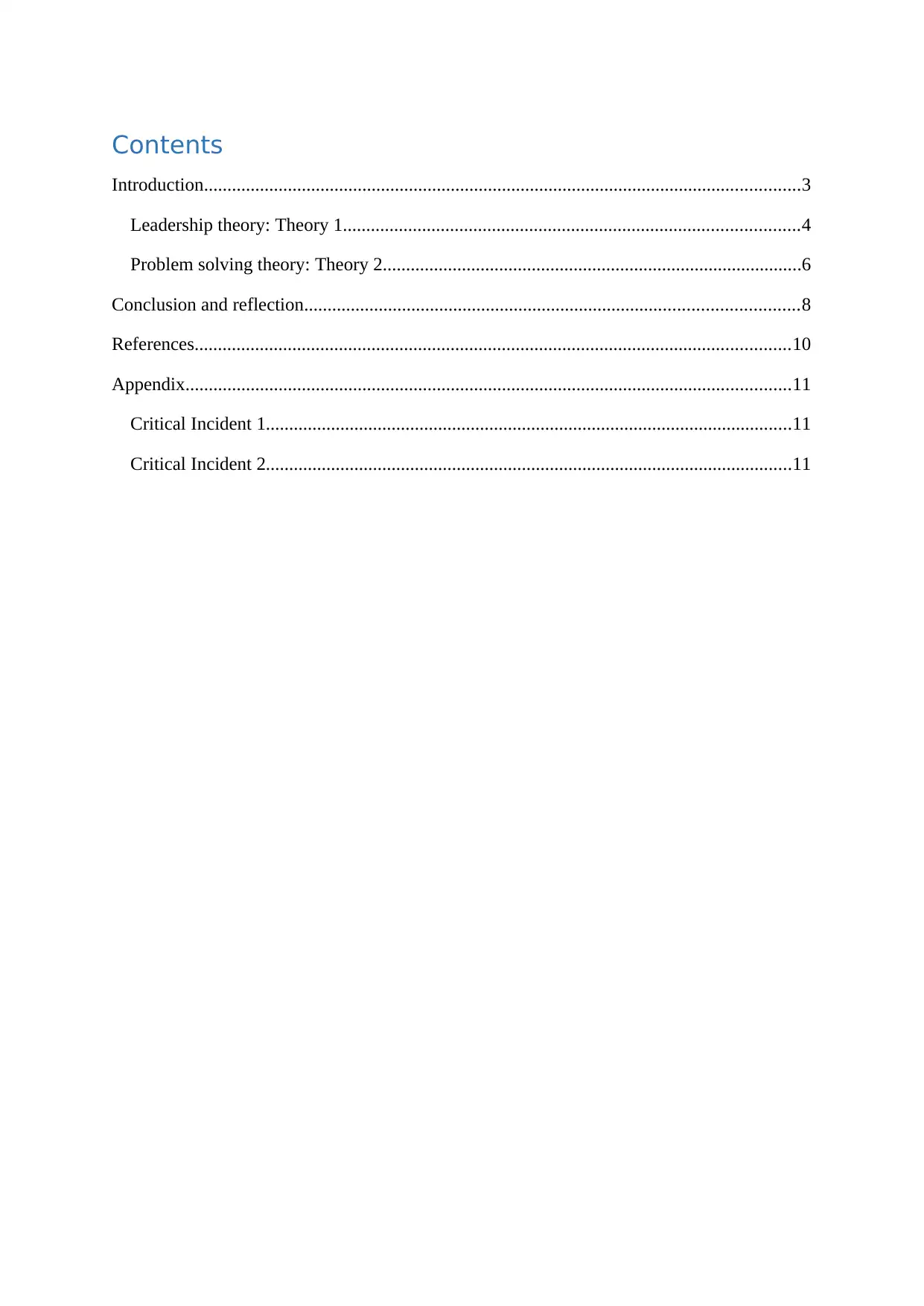
Contents
Introduction................................................................................................................................3
Leadership theory: Theory 1..................................................................................................4
Problem solving theory: Theory 2..........................................................................................6
Conclusion and reflection..........................................................................................................8
References................................................................................................................................10
Appendix..................................................................................................................................11
Critical Incident 1.................................................................................................................11
Critical Incident 2.................................................................................................................11
Introduction................................................................................................................................3
Leadership theory: Theory 1..................................................................................................4
Problem solving theory: Theory 2..........................................................................................6
Conclusion and reflection..........................................................................................................8
References................................................................................................................................10
Appendix..................................................................................................................................11
Critical Incident 1.................................................................................................................11
Critical Incident 2.................................................................................................................11
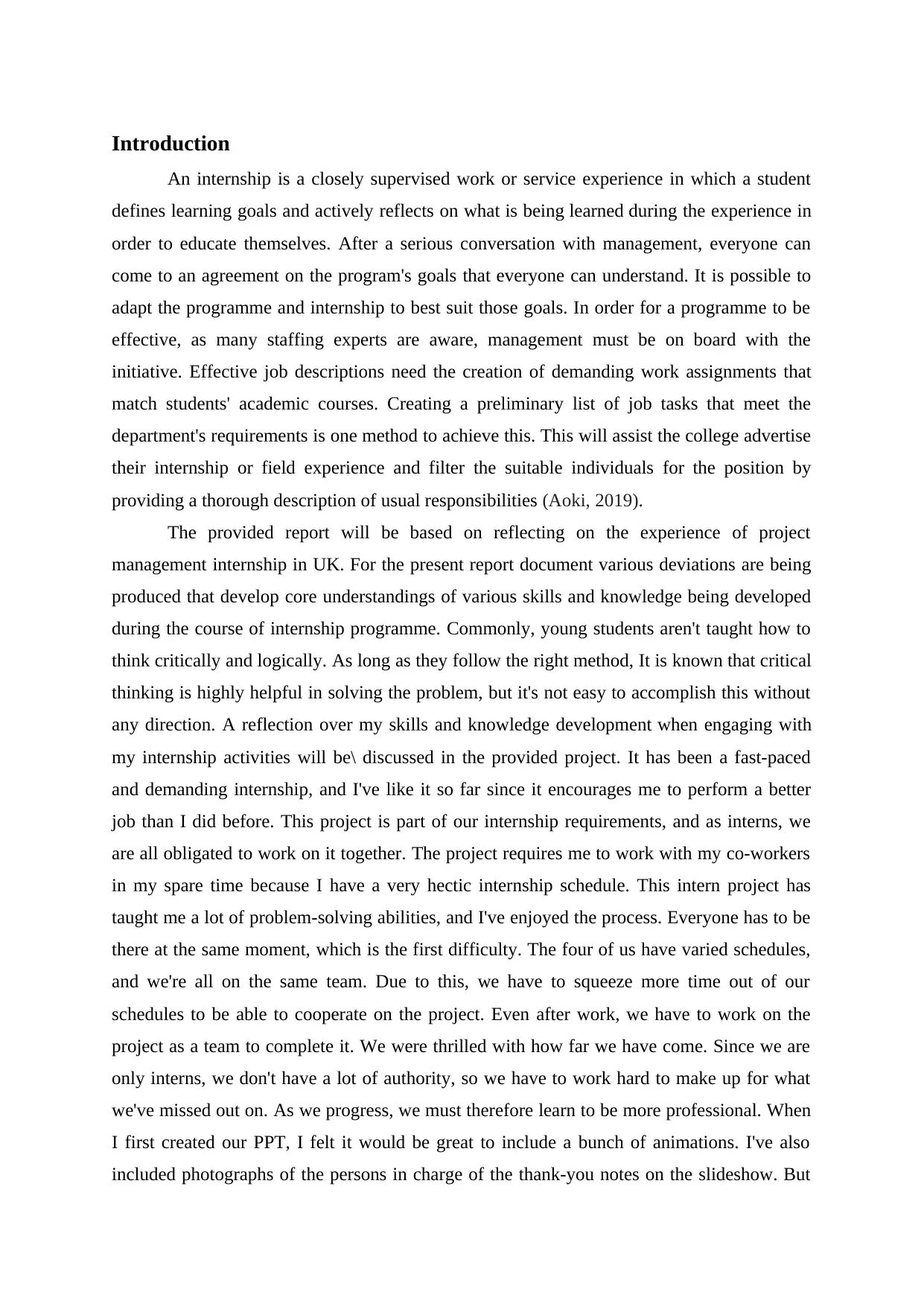
Introduction
An internship is a closely supervised work or service experience in which a student
defines learning goals and actively reflects on what is being learned during the experience in
order to educate themselves. After a serious conversation with management, everyone can
come to an agreement on the program's goals that everyone can understand. It is possible to
adapt the programme and internship to best suit those goals. In order for a programme to be
effective, as many staffing experts are aware, management must be on board with the
initiative. Effective job descriptions need the creation of demanding work assignments that
match students' academic courses. Creating a preliminary list of job tasks that meet the
department's requirements is one method to achieve this. This will assist the college advertise
their internship or field experience and filter the suitable individuals for the position by
providing a thorough description of usual responsibilities (Aoki, 2019).
The provided report will be based on reflecting on the experience of project
management internship in UK. For the present report document various deviations are being
produced that develop core understandings of various skills and knowledge being developed
during the course of internship programme. Commonly, young students aren't taught how to
think critically and logically. As long as they follow the right method, It is known that critical
thinking is highly helpful in solving the problem, but it's not easy to accomplish this without
any direction. A reflection over my skills and knowledge development when engaging with
my internship activities will be\ discussed in the provided project. It has been a fast-paced
and demanding internship, and I've like it so far since it encourages me to perform a better
job than I did before. This project is part of our internship requirements, and as interns, we
are all obligated to work on it together. The project requires me to work with my co-workers
in my spare time because I have a very hectic internship schedule. This intern project has
taught me a lot of problem-solving abilities, and I've enjoyed the process. Everyone has to be
there at the same moment, which is the first difficulty. The four of us have varied schedules,
and we're all on the same team. Due to this, we have to squeeze more time out of our
schedules to be able to cooperate on the project. Even after work, we have to work on the
project as a team to complete it. We were thrilled with how far we have come. Since we are
only interns, we don't have a lot of authority, so we have to work hard to make up for what
we've missed out on. As we progress, we must therefore learn to be more professional. When
I first created our PPT, I felt it would be great to include a bunch of animations. I've also
included photographs of the persons in charge of the thank-you notes on the slideshow. But
An internship is a closely supervised work or service experience in which a student
defines learning goals and actively reflects on what is being learned during the experience in
order to educate themselves. After a serious conversation with management, everyone can
come to an agreement on the program's goals that everyone can understand. It is possible to
adapt the programme and internship to best suit those goals. In order for a programme to be
effective, as many staffing experts are aware, management must be on board with the
initiative. Effective job descriptions need the creation of demanding work assignments that
match students' academic courses. Creating a preliminary list of job tasks that meet the
department's requirements is one method to achieve this. This will assist the college advertise
their internship or field experience and filter the suitable individuals for the position by
providing a thorough description of usual responsibilities (Aoki, 2019).
The provided report will be based on reflecting on the experience of project
management internship in UK. For the present report document various deviations are being
produced that develop core understandings of various skills and knowledge being developed
during the course of internship programme. Commonly, young students aren't taught how to
think critically and logically. As long as they follow the right method, It is known that critical
thinking is highly helpful in solving the problem, but it's not easy to accomplish this without
any direction. A reflection over my skills and knowledge development when engaging with
my internship activities will be\ discussed in the provided project. It has been a fast-paced
and demanding internship, and I've like it so far since it encourages me to perform a better
job than I did before. This project is part of our internship requirements, and as interns, we
are all obligated to work on it together. The project requires me to work with my co-workers
in my spare time because I have a very hectic internship schedule. This intern project has
taught me a lot of problem-solving abilities, and I've enjoyed the process. Everyone has to be
there at the same moment, which is the first difficulty. The four of us have varied schedules,
and we're all on the same team. Due to this, we have to squeeze more time out of our
schedules to be able to cooperate on the project. Even after work, we have to work on the
project as a team to complete it. We were thrilled with how far we have come. Since we are
only interns, we don't have a lot of authority, so we have to work hard to make up for what
we've missed out on. As we progress, we must therefore learn to be more professional. When
I first created our PPT, I felt it would be great to include a bunch of animations. I've also
included photographs of the persons in charge of the thank-you notes on the slideshow. But
⊘ This is a preview!⊘
Do you want full access?
Subscribe today to unlock all pages.

Trusted by 1+ million students worldwide
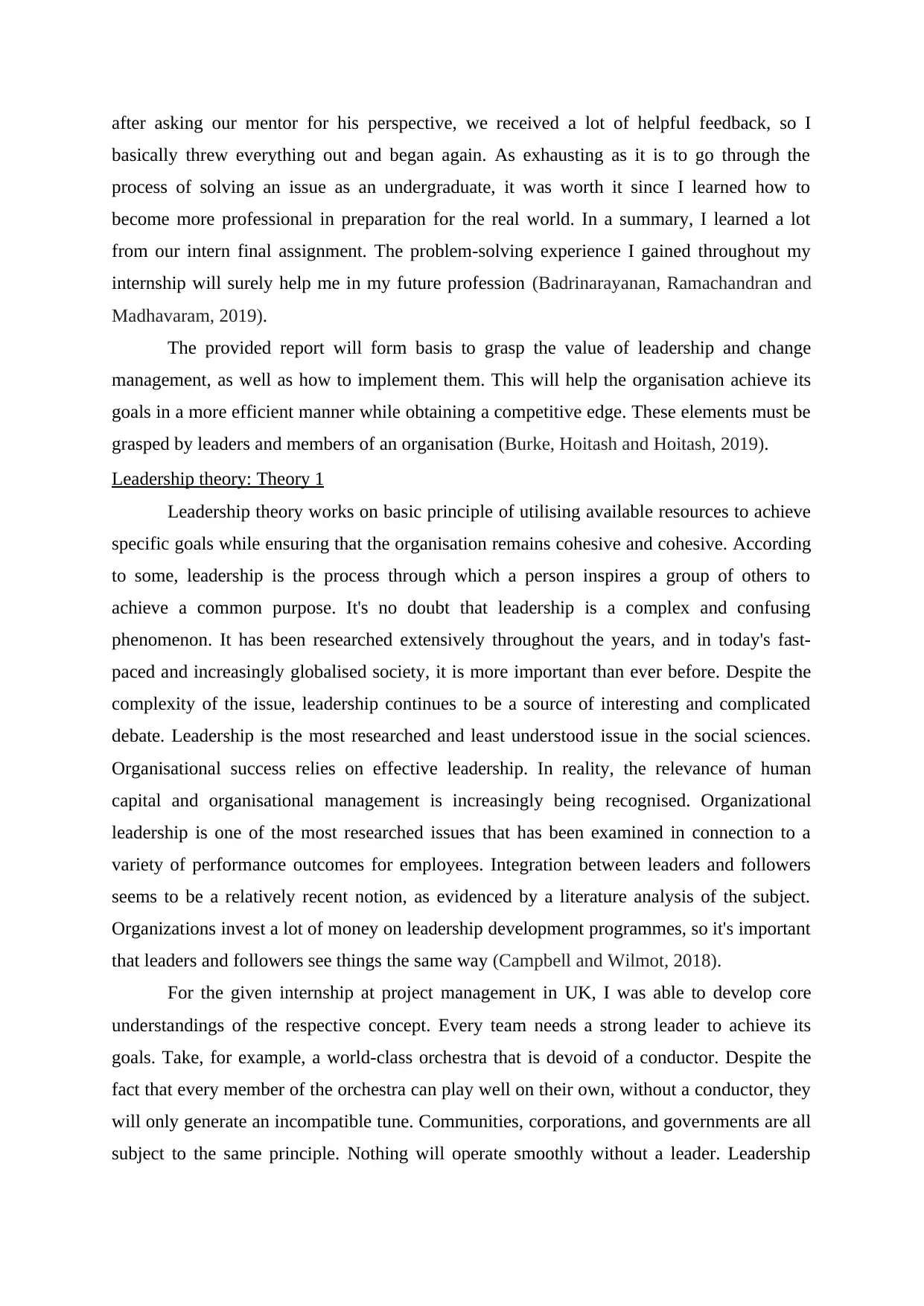
after asking our mentor for his perspective, we received a lot of helpful feedback, so I
basically threw everything out and began again. As exhausting as it is to go through the
process of solving an issue as an undergraduate, it was worth it since I learned how to
become more professional in preparation for the real world. In a summary, I learned a lot
from our intern final assignment. The problem-solving experience I gained throughout my
internship will surely help me in my future profession (Badrinarayanan, Ramachandran and
Madhavaram, 2019).
The provided report will form basis to grasp the value of leadership and change
management, as well as how to implement them. This will help the organisation achieve its
goals in a more efficient manner while obtaining a competitive edge. These elements must be
grasped by leaders and members of an organisation (Burke, Hoitash and Hoitash, 2019).
Leadership theory: Theory 1
Leadership theory works on basic principle of utilising available resources to achieve
specific goals while ensuring that the organisation remains cohesive and cohesive. According
to some, leadership is the process through which a person inspires a group of others to
achieve a common purpose. It's no doubt that leadership is a complex and confusing
phenomenon. It has been researched extensively throughout the years, and in today's fast-
paced and increasingly globalised society, it is more important than ever before. Despite the
complexity of the issue, leadership continues to be a source of interesting and complicated
debate. Leadership is the most researched and least understood issue in the social sciences.
Organisational success relies on effective leadership. In reality, the relevance of human
capital and organisational management is increasingly being recognised. Organizational
leadership is one of the most researched issues that has been examined in connection to a
variety of performance outcomes for employees. Integration between leaders and followers
seems to be a relatively recent notion, as evidenced by a literature analysis of the subject.
Organizations invest a lot of money on leadership development programmes, so it's important
that leaders and followers see things the same way (Campbell and Wilmot, 2018).
For the given internship at project management in UK, I was able to develop core
understandings of the respective concept. Every team needs a strong leader to achieve its
goals. Take, for example, a world-class orchestra that is devoid of a conductor. Despite the
fact that every member of the orchestra can play well on their own, without a conductor, they
will only generate an incompatible tune. Communities, corporations, and governments are all
subject to the same principle. Nothing will operate smoothly without a leader. Leadership
basically threw everything out and began again. As exhausting as it is to go through the
process of solving an issue as an undergraduate, it was worth it since I learned how to
become more professional in preparation for the real world. In a summary, I learned a lot
from our intern final assignment. The problem-solving experience I gained throughout my
internship will surely help me in my future profession (Badrinarayanan, Ramachandran and
Madhavaram, 2019).
The provided report will form basis to grasp the value of leadership and change
management, as well as how to implement them. This will help the organisation achieve its
goals in a more efficient manner while obtaining a competitive edge. These elements must be
grasped by leaders and members of an organisation (Burke, Hoitash and Hoitash, 2019).
Leadership theory: Theory 1
Leadership theory works on basic principle of utilising available resources to achieve
specific goals while ensuring that the organisation remains cohesive and cohesive. According
to some, leadership is the process through which a person inspires a group of others to
achieve a common purpose. It's no doubt that leadership is a complex and confusing
phenomenon. It has been researched extensively throughout the years, and in today's fast-
paced and increasingly globalised society, it is more important than ever before. Despite the
complexity of the issue, leadership continues to be a source of interesting and complicated
debate. Leadership is the most researched and least understood issue in the social sciences.
Organisational success relies on effective leadership. In reality, the relevance of human
capital and organisational management is increasingly being recognised. Organizational
leadership is one of the most researched issues that has been examined in connection to a
variety of performance outcomes for employees. Integration between leaders and followers
seems to be a relatively recent notion, as evidenced by a literature analysis of the subject.
Organizations invest a lot of money on leadership development programmes, so it's important
that leaders and followers see things the same way (Campbell and Wilmot, 2018).
For the given internship at project management in UK, I was able to develop core
understandings of the respective concept. Every team needs a strong leader to achieve its
goals. Take, for example, a world-class orchestra that is devoid of a conductor. Despite the
fact that every member of the orchestra can play well on their own, without a conductor, they
will only generate an incompatible tune. Communities, corporations, and governments are all
subject to the same principle. Nothing will operate smoothly without a leader. Leadership
Paraphrase This Document
Need a fresh take? Get an instant paraphrase of this document with our AI Paraphraser
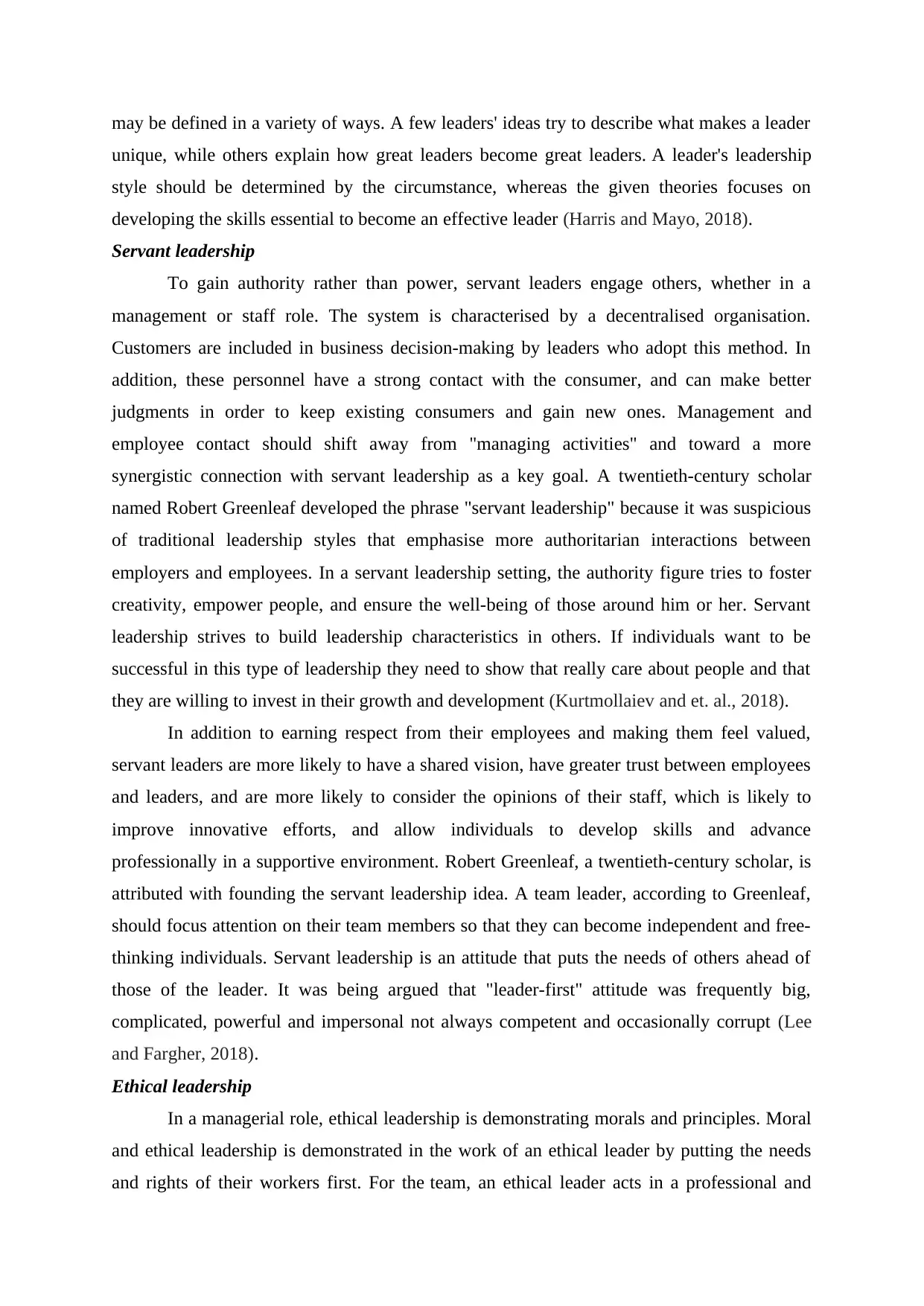
may be defined in a variety of ways. A few leaders' ideas try to describe what makes a leader
unique, while others explain how great leaders become great leaders. A leader's leadership
style should be determined by the circumstance, whereas the given theories focuses on
developing the skills essential to become an effective leader (Harris and Mayo, 2018).
Servant leadership
To gain authority rather than power, servant leaders engage others, whether in a
management or staff role. The system is characterised by a decentralised organisation.
Customers are included in business decision-making by leaders who adopt this method. In
addition, these personnel have a strong contact with the consumer, and can make better
judgments in order to keep existing consumers and gain new ones. Management and
employee contact should shift away from "managing activities" and toward a more
synergistic connection with servant leadership as a key goal. A twentieth-century scholar
named Robert Greenleaf developed the phrase "servant leadership" because it was suspicious
of traditional leadership styles that emphasise more authoritarian interactions between
employers and employees. In a servant leadership setting, the authority figure tries to foster
creativity, empower people, and ensure the well-being of those around him or her. Servant
leadership strives to build leadership characteristics in others. If individuals want to be
successful in this type of leadership they need to show that really care about people and that
they are willing to invest in their growth and development (Kurtmollaiev and et. al., 2018).
In addition to earning respect from their employees and making them feel valued,
servant leaders are more likely to have a shared vision, have greater trust between employees
and leaders, and are more likely to consider the opinions of their staff, which is likely to
improve innovative efforts, and allow individuals to develop skills and advance
professionally in a supportive environment. Robert Greenleaf, a twentieth-century scholar, is
attributed with founding the servant leadership idea. A team leader, according to Greenleaf,
should focus attention on their team members so that they can become independent and free-
thinking individuals. Servant leadership is an attitude that puts the needs of others ahead of
those of the leader. It was being argued that "leader-first" attitude was frequently big,
complicated, powerful and impersonal not always competent and occasionally corrupt (Lee
and Fargher, 2018).
Ethical leadership
In a managerial role, ethical leadership is demonstrating morals and principles. Moral
and ethical leadership is demonstrated in the work of an ethical leader by putting the needs
and rights of their workers first. For the team, an ethical leader acts in a professional and
unique, while others explain how great leaders become great leaders. A leader's leadership
style should be determined by the circumstance, whereas the given theories focuses on
developing the skills essential to become an effective leader (Harris and Mayo, 2018).
Servant leadership
To gain authority rather than power, servant leaders engage others, whether in a
management or staff role. The system is characterised by a decentralised organisation.
Customers are included in business decision-making by leaders who adopt this method. In
addition, these personnel have a strong contact with the consumer, and can make better
judgments in order to keep existing consumers and gain new ones. Management and
employee contact should shift away from "managing activities" and toward a more
synergistic connection with servant leadership as a key goal. A twentieth-century scholar
named Robert Greenleaf developed the phrase "servant leadership" because it was suspicious
of traditional leadership styles that emphasise more authoritarian interactions between
employers and employees. In a servant leadership setting, the authority figure tries to foster
creativity, empower people, and ensure the well-being of those around him or her. Servant
leadership strives to build leadership characteristics in others. If individuals want to be
successful in this type of leadership they need to show that really care about people and that
they are willing to invest in their growth and development (Kurtmollaiev and et. al., 2018).
In addition to earning respect from their employees and making them feel valued,
servant leaders are more likely to have a shared vision, have greater trust between employees
and leaders, and are more likely to consider the opinions of their staff, which is likely to
improve innovative efforts, and allow individuals to develop skills and advance
professionally in a supportive environment. Robert Greenleaf, a twentieth-century scholar, is
attributed with founding the servant leadership idea. A team leader, according to Greenleaf,
should focus attention on their team members so that they can become independent and free-
thinking individuals. Servant leadership is an attitude that puts the needs of others ahead of
those of the leader. It was being argued that "leader-first" attitude was frequently big,
complicated, powerful and impersonal not always competent and occasionally corrupt (Lee
and Fargher, 2018).
Ethical leadership
In a managerial role, ethical leadership is demonstrating morals and principles. Moral
and ethical leadership is demonstrated in the work of an ethical leader by putting the needs
and rights of their workers first. For the team, an ethical leader acts in a professional and
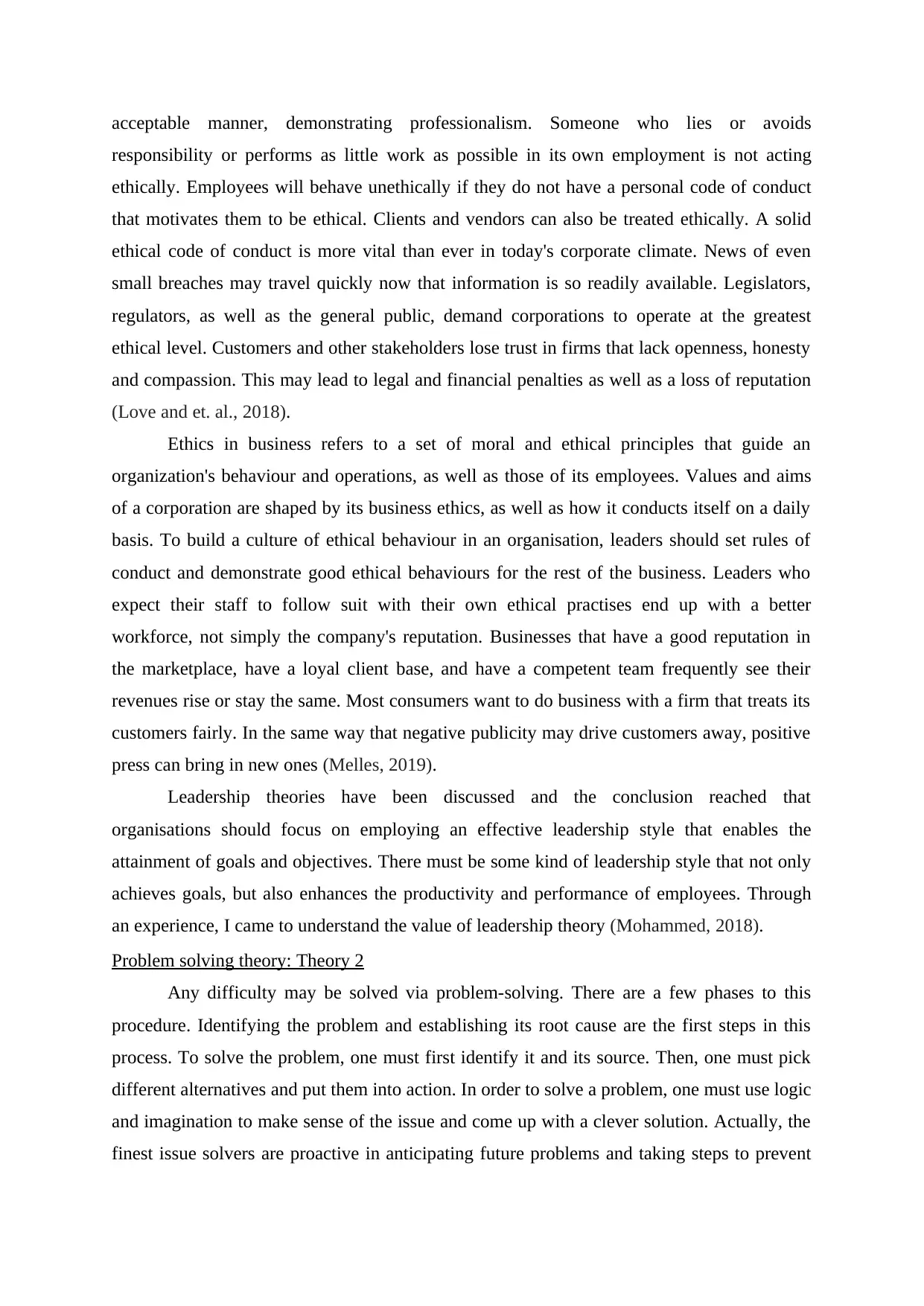
acceptable manner, demonstrating professionalism. Someone who lies or avoids
responsibility or performs as little work as possible in its own employment is not acting
ethically. Employees will behave unethically if they do not have a personal code of conduct
that motivates them to be ethical. Clients and vendors can also be treated ethically. A solid
ethical code of conduct is more vital than ever in today's corporate climate. News of even
small breaches may travel quickly now that information is so readily available. Legislators,
regulators, as well as the general public, demand corporations to operate at the greatest
ethical level. Customers and other stakeholders lose trust in firms that lack openness, honesty
and compassion. This may lead to legal and financial penalties as well as a loss of reputation
(Love and et. al., 2018).
Ethics in business refers to a set of moral and ethical principles that guide an
organization's behaviour and operations, as well as those of its employees. Values and aims
of a corporation are shaped by its business ethics, as well as how it conducts itself on a daily
basis. To build a culture of ethical behaviour in an organisation, leaders should set rules of
conduct and demonstrate good ethical behaviours for the rest of the business. Leaders who
expect their staff to follow suit with their own ethical practises end up with a better
workforce, not simply the company's reputation. Businesses that have a good reputation in
the marketplace, have a loyal client base, and have a competent team frequently see their
revenues rise or stay the same. Most consumers want to do business with a firm that treats its
customers fairly. In the same way that negative publicity may drive customers away, positive
press can bring in new ones (Melles, 2019).
Leadership theories have been discussed and the conclusion reached that
organisations should focus on employing an effective leadership style that enables the
attainment of goals and objectives. There must be some kind of leadership style that not only
achieves goals, but also enhances the productivity and performance of employees. Through
an experience, I came to understand the value of leadership theory (Mohammed, 2018).
Problem solving theory: Theory 2
Any difficulty may be solved via problem-solving. There are a few phases to this
procedure. Identifying the problem and establishing its root cause are the first steps in this
process. To solve the problem, one must first identify it and its source. Then, one must pick
different alternatives and put them into action. In order to solve a problem, one must use logic
and imagination to make sense of the issue and come up with a clever solution. Actually, the
finest issue solvers are proactive in anticipating future problems and taking steps to prevent
responsibility or performs as little work as possible in its own employment is not acting
ethically. Employees will behave unethically if they do not have a personal code of conduct
that motivates them to be ethical. Clients and vendors can also be treated ethically. A solid
ethical code of conduct is more vital than ever in today's corporate climate. News of even
small breaches may travel quickly now that information is so readily available. Legislators,
regulators, as well as the general public, demand corporations to operate at the greatest
ethical level. Customers and other stakeholders lose trust in firms that lack openness, honesty
and compassion. This may lead to legal and financial penalties as well as a loss of reputation
(Love and et. al., 2018).
Ethics in business refers to a set of moral and ethical principles that guide an
organization's behaviour and operations, as well as those of its employees. Values and aims
of a corporation are shaped by its business ethics, as well as how it conducts itself on a daily
basis. To build a culture of ethical behaviour in an organisation, leaders should set rules of
conduct and demonstrate good ethical behaviours for the rest of the business. Leaders who
expect their staff to follow suit with their own ethical practises end up with a better
workforce, not simply the company's reputation. Businesses that have a good reputation in
the marketplace, have a loyal client base, and have a competent team frequently see their
revenues rise or stay the same. Most consumers want to do business with a firm that treats its
customers fairly. In the same way that negative publicity may drive customers away, positive
press can bring in new ones (Melles, 2019).
Leadership theories have been discussed and the conclusion reached that
organisations should focus on employing an effective leadership style that enables the
attainment of goals and objectives. There must be some kind of leadership style that not only
achieves goals, but also enhances the productivity and performance of employees. Through
an experience, I came to understand the value of leadership theory (Mohammed, 2018).
Problem solving theory: Theory 2
Any difficulty may be solved via problem-solving. There are a few phases to this
procedure. Identifying the problem and establishing its root cause are the first steps in this
process. To solve the problem, one must first identify it and its source. Then, one must pick
different alternatives and put them into action. In order to solve a problem, one must use logic
and imagination to make sense of the issue and come up with a clever solution. Actually, the
finest issue solvers are proactive in anticipating future problems and taking steps to prevent
⊘ This is a preview!⊘
Do you want full access?
Subscribe today to unlock all pages.

Trusted by 1+ million students worldwide
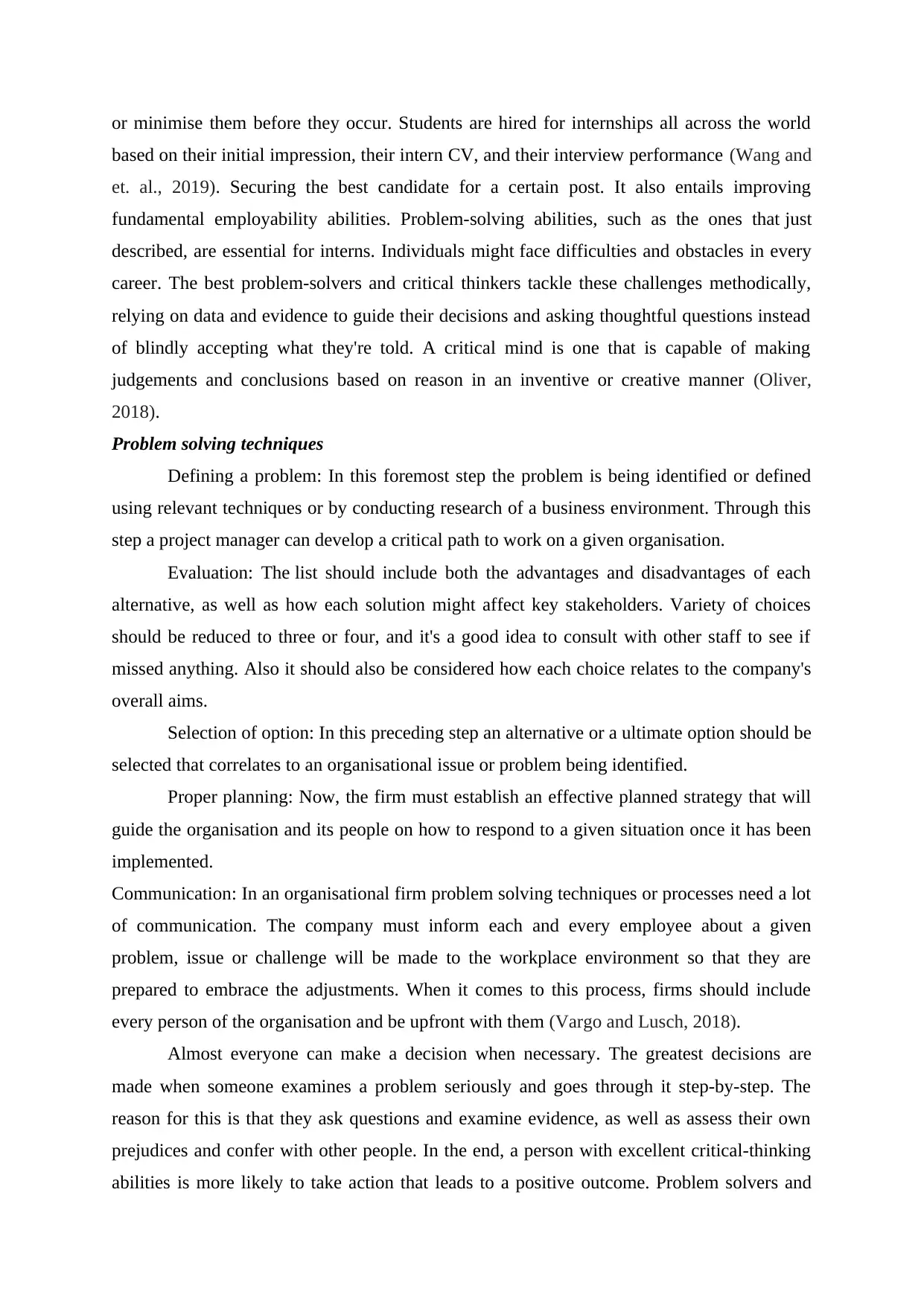
or minimise them before they occur. Students are hired for internships all across the world
based on their initial impression, their intern CV, and their interview performance (Wang and
et. al., 2019). Securing the best candidate for a certain post. It also entails improving
fundamental employability abilities. Problem-solving abilities, such as the ones that just
described, are essential for interns. Individuals might face difficulties and obstacles in every
career. The best problem-solvers and critical thinkers tackle these challenges methodically,
relying on data and evidence to guide their decisions and asking thoughtful questions instead
of blindly accepting what they're told. A critical mind is one that is capable of making
judgements and conclusions based on reason in an inventive or creative manner (Oliver,
2018).
Problem solving techniques
Defining a problem: In this foremost step the problem is being identified or defined
using relevant techniques or by conducting research of a business environment. Through this
step a project manager can develop a critical path to work on a given organisation.
Evaluation: The list should include both the advantages and disadvantages of each
alternative, as well as how each solution might affect key stakeholders. Variety of choices
should be reduced to three or four, and it's a good idea to consult with other staff to see if
missed anything. Also it should also be considered how each choice relates to the company's
overall aims.
Selection of option: In this preceding step an alternative or a ultimate option should be
selected that correlates to an organisational issue or problem being identified.
Proper planning: Now, the firm must establish an effective planned strategy that will
guide the organisation and its people on how to respond to a given situation once it has been
implemented.
Communication: In an organisational firm problem solving techniques or processes need a lot
of communication. The company must inform each and every employee about a given
problem, issue or challenge will be made to the workplace environment so that they are
prepared to embrace the adjustments. When it comes to this process, firms should include
every person of the organisation and be upfront with them (Vargo and Lusch, 2018).
Almost everyone can make a decision when necessary. The greatest decisions are
made when someone examines a problem seriously and goes through it step-by-step. The
reason for this is that they ask questions and examine evidence, as well as assess their own
prejudices and confer with other people. In the end, a person with excellent critical-thinking
abilities is more likely to take action that leads to a positive outcome. Problem solvers and
based on their initial impression, their intern CV, and their interview performance (Wang and
et. al., 2019). Securing the best candidate for a certain post. It also entails improving
fundamental employability abilities. Problem-solving abilities, such as the ones that just
described, are essential for interns. Individuals might face difficulties and obstacles in every
career. The best problem-solvers and critical thinkers tackle these challenges methodically,
relying on data and evidence to guide their decisions and asking thoughtful questions instead
of blindly accepting what they're told. A critical mind is one that is capable of making
judgements and conclusions based on reason in an inventive or creative manner (Oliver,
2018).
Problem solving techniques
Defining a problem: In this foremost step the problem is being identified or defined
using relevant techniques or by conducting research of a business environment. Through this
step a project manager can develop a critical path to work on a given organisation.
Evaluation: The list should include both the advantages and disadvantages of each
alternative, as well as how each solution might affect key stakeholders. Variety of choices
should be reduced to three or four, and it's a good idea to consult with other staff to see if
missed anything. Also it should also be considered how each choice relates to the company's
overall aims.
Selection of option: In this preceding step an alternative or a ultimate option should be
selected that correlates to an organisational issue or problem being identified.
Proper planning: Now, the firm must establish an effective planned strategy that will
guide the organisation and its people on how to respond to a given situation once it has been
implemented.
Communication: In an organisational firm problem solving techniques or processes need a lot
of communication. The company must inform each and every employee about a given
problem, issue or challenge will be made to the workplace environment so that they are
prepared to embrace the adjustments. When it comes to this process, firms should include
every person of the organisation and be upfront with them (Vargo and Lusch, 2018).
Almost everyone can make a decision when necessary. The greatest decisions are
made when someone examines a problem seriously and goes through it step-by-step. The
reason for this is that they ask questions and examine evidence, as well as assess their own
prejudices and confer with other people. In the end, a person with excellent critical-thinking
abilities is more likely to take action that leads to a positive outcome. Problem solvers and
Paraphrase This Document
Need a fresh take? Get an instant paraphrase of this document with our AI Paraphraser
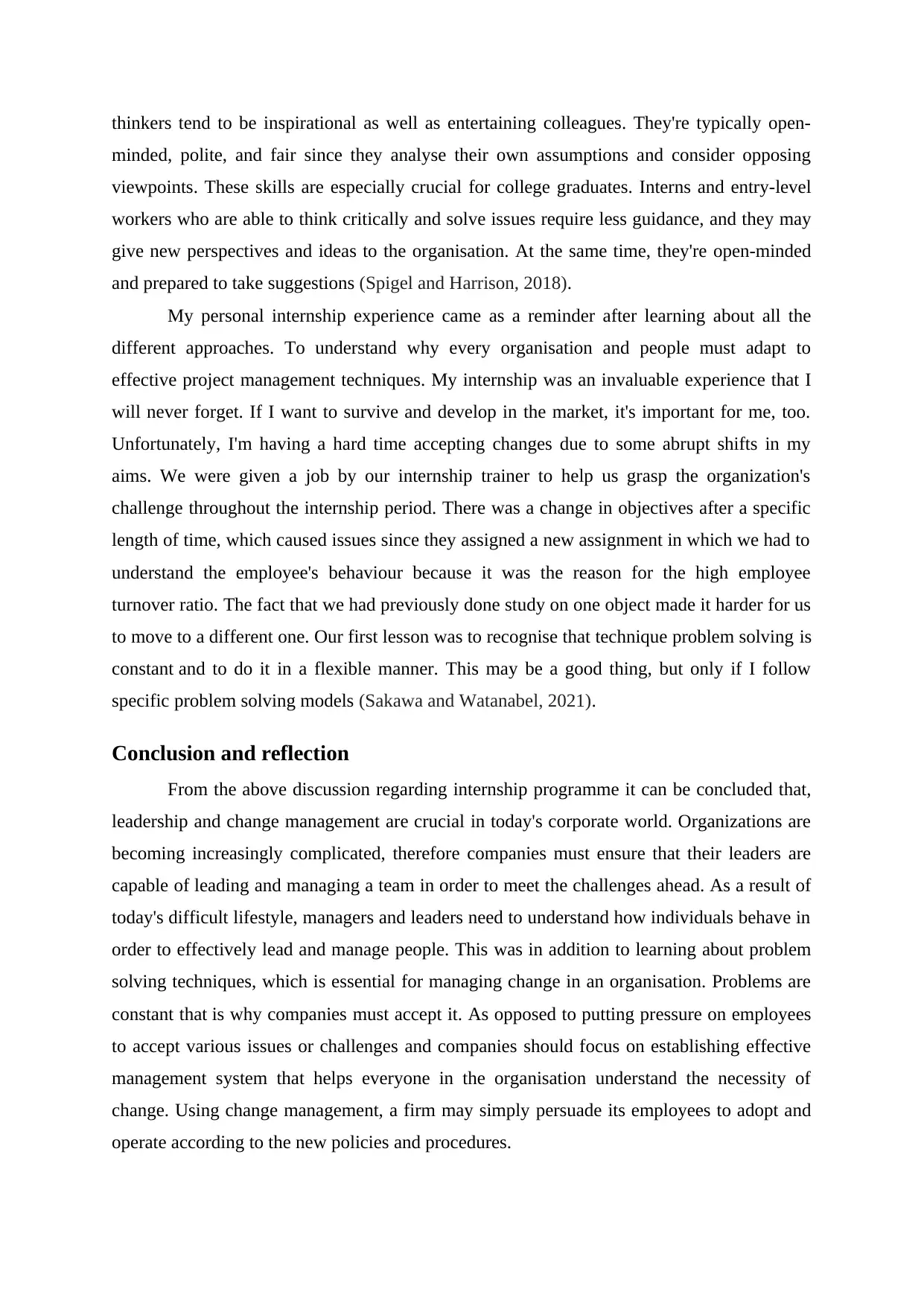
thinkers tend to be inspirational as well as entertaining colleagues. They're typically open-
minded, polite, and fair since they analyse their own assumptions and consider opposing
viewpoints. These skills are especially crucial for college graduates. Interns and entry-level
workers who are able to think critically and solve issues require less guidance, and they may
give new perspectives and ideas to the organisation. At the same time, they're open-minded
and prepared to take suggestions (Spigel and Harrison, 2018).
My personal internship experience came as a reminder after learning about all the
different approaches. To understand why every organisation and people must adapt to
effective project management techniques. My internship was an invaluable experience that I
will never forget. If I want to survive and develop in the market, it's important for me, too.
Unfortunately, I'm having a hard time accepting changes due to some abrupt shifts in my
aims. We were given a job by our internship trainer to help us grasp the organization's
challenge throughout the internship period. There was a change in objectives after a specific
length of time, which caused issues since they assigned a new assignment in which we had to
understand the employee's behaviour because it was the reason for the high employee
turnover ratio. The fact that we had previously done study on one object made it harder for us
to move to a different one. Our first lesson was to recognise that technique problem solving is
constant and to do it in a flexible manner. This may be a good thing, but only if I follow
specific problem solving models (Sakawa and Watanabel, 2021).
Conclusion and reflection
From the above discussion regarding internship programme it can be concluded that,
leadership and change management are crucial in today's corporate world. Organizations are
becoming increasingly complicated, therefore companies must ensure that their leaders are
capable of leading and managing a team in order to meet the challenges ahead. As a result of
today's difficult lifestyle, managers and leaders need to understand how individuals behave in
order to effectively lead and manage people. This was in addition to learning about problem
solving techniques, which is essential for managing change in an organisation. Problems are
constant that is why companies must accept it. As opposed to putting pressure on employees
to accept various issues or challenges and companies should focus on establishing effective
management system that helps everyone in the organisation understand the necessity of
change. Using change management, a firm may simply persuade its employees to adopt and
operate according to the new policies and procedures.
minded, polite, and fair since they analyse their own assumptions and consider opposing
viewpoints. These skills are especially crucial for college graduates. Interns and entry-level
workers who are able to think critically and solve issues require less guidance, and they may
give new perspectives and ideas to the organisation. At the same time, they're open-minded
and prepared to take suggestions (Spigel and Harrison, 2018).
My personal internship experience came as a reminder after learning about all the
different approaches. To understand why every organisation and people must adapt to
effective project management techniques. My internship was an invaluable experience that I
will never forget. If I want to survive and develop in the market, it's important for me, too.
Unfortunately, I'm having a hard time accepting changes due to some abrupt shifts in my
aims. We were given a job by our internship trainer to help us grasp the organization's
challenge throughout the internship period. There was a change in objectives after a specific
length of time, which caused issues since they assigned a new assignment in which we had to
understand the employee's behaviour because it was the reason for the high employee
turnover ratio. The fact that we had previously done study on one object made it harder for us
to move to a different one. Our first lesson was to recognise that technique problem solving is
constant and to do it in a flexible manner. This may be a good thing, but only if I follow
specific problem solving models (Sakawa and Watanabel, 2021).
Conclusion and reflection
From the above discussion regarding internship programme it can be concluded that,
leadership and change management are crucial in today's corporate world. Organizations are
becoming increasingly complicated, therefore companies must ensure that their leaders are
capable of leading and managing a team in order to meet the challenges ahead. As a result of
today's difficult lifestyle, managers and leaders need to understand how individuals behave in
order to effectively lead and manage people. This was in addition to learning about problem
solving techniques, which is essential for managing change in an organisation. Problems are
constant that is why companies must accept it. As opposed to putting pressure on employees
to accept various issues or challenges and companies should focus on establishing effective
management system that helps everyone in the organisation understand the necessity of
change. Using change management, a firm may simply persuade its employees to adopt and
operate according to the new policies and procedures.
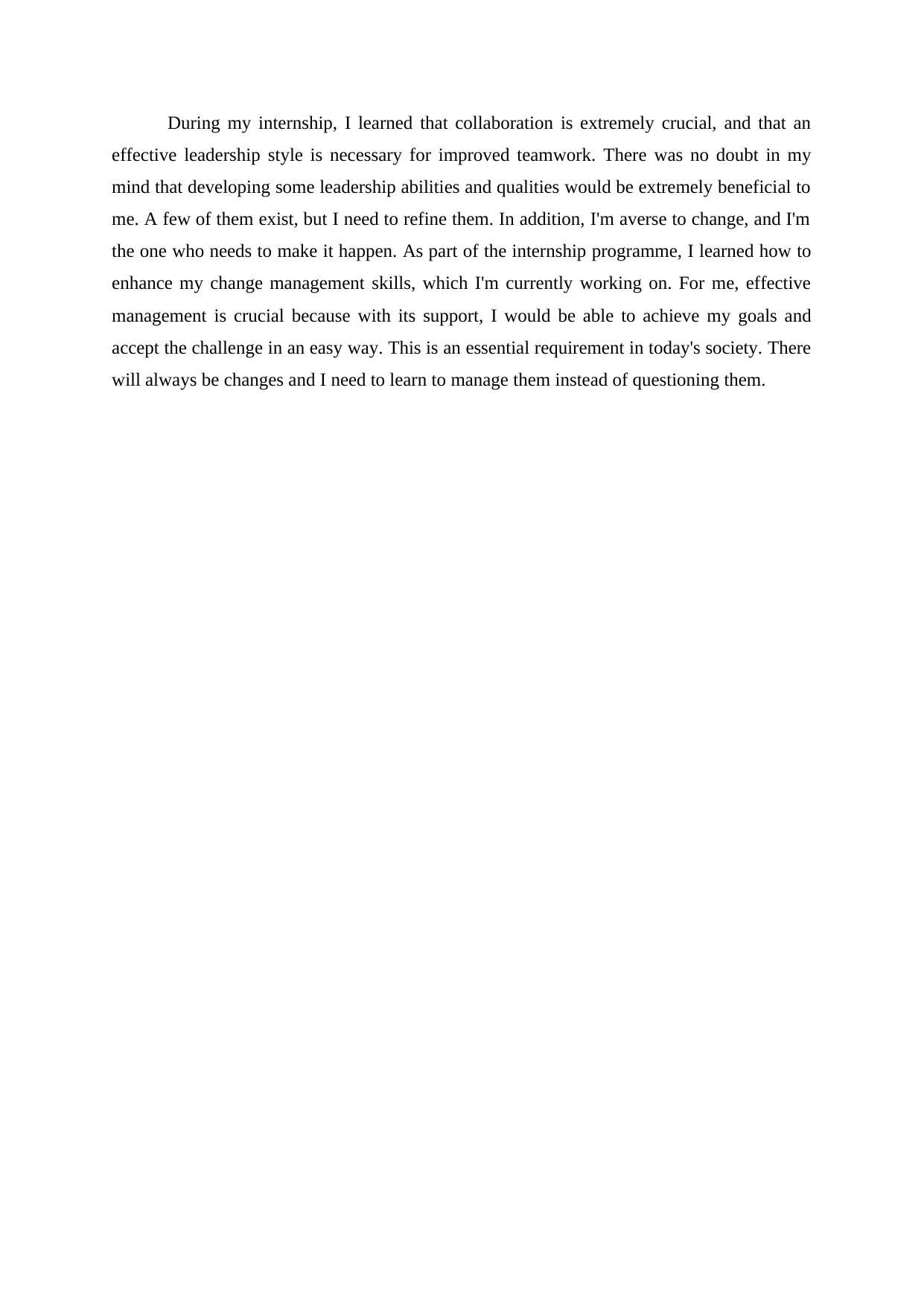
During my internship, I learned that collaboration is extremely crucial, and that an
effective leadership style is necessary for improved teamwork. There was no doubt in my
mind that developing some leadership abilities and qualities would be extremely beneficial to
me. A few of them exist, but I need to refine them. In addition, I'm averse to change, and I'm
the one who needs to make it happen. As part of the internship programme, I learned how to
enhance my change management skills, which I'm currently working on. For me, effective
management is crucial because with its support, I would be able to achieve my goals and
accept the challenge in an easy way. This is an essential requirement in today's society. There
will always be changes and I need to learn to manage them instead of questioning them.
effective leadership style is necessary for improved teamwork. There was no doubt in my
mind that developing some leadership abilities and qualities would be extremely beneficial to
me. A few of them exist, but I need to refine them. In addition, I'm averse to change, and I'm
the one who needs to make it happen. As part of the internship programme, I learned how to
enhance my change management skills, which I'm currently working on. For me, effective
management is crucial because with its support, I would be able to achieve my goals and
accept the challenge in an easy way. This is an essential requirement in today's society. There
will always be changes and I need to learn to manage them instead of questioning them.
⊘ This is a preview!⊘
Do you want full access?
Subscribe today to unlock all pages.

Trusted by 1+ million students worldwide
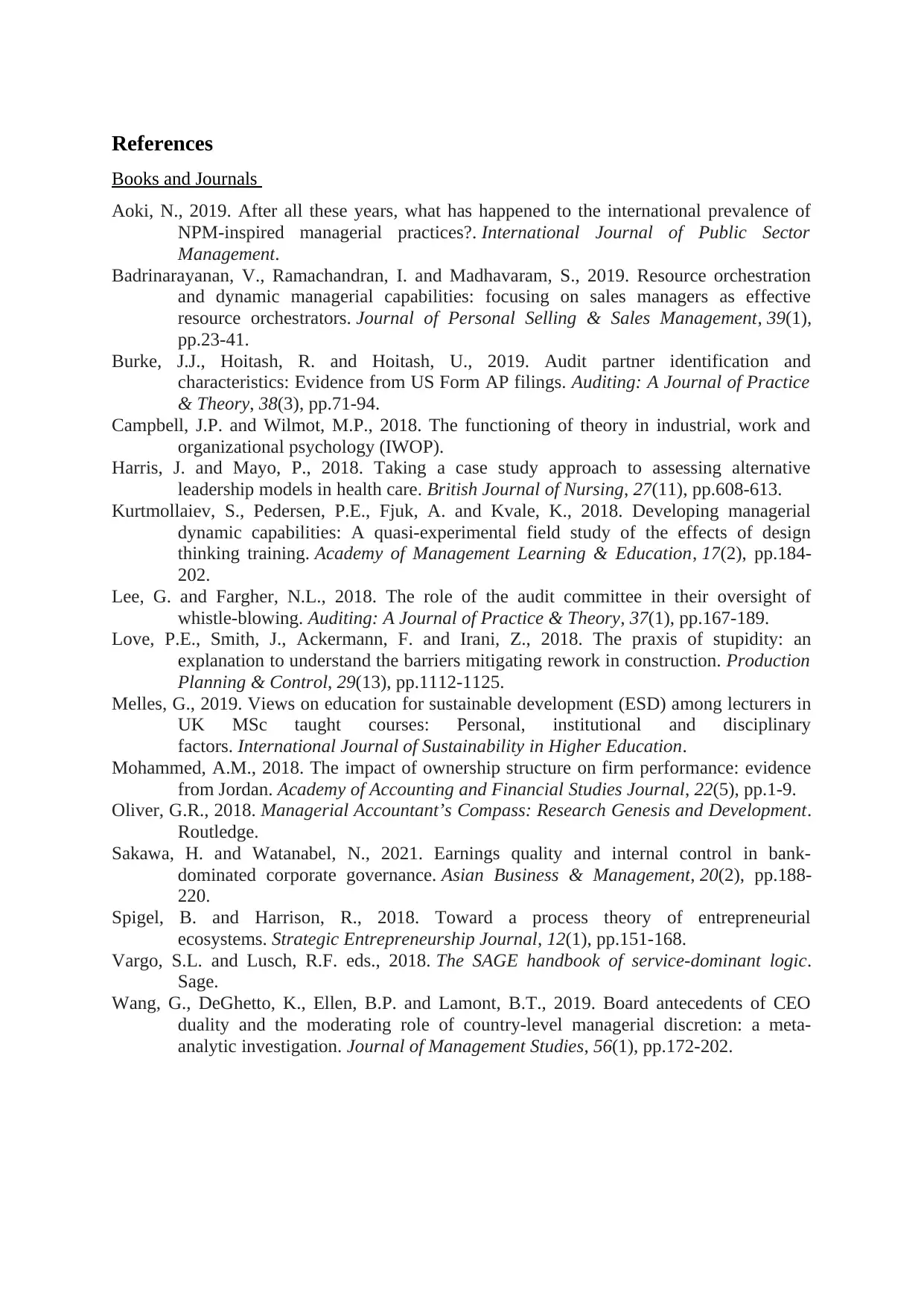
References
Books and Journals
Aoki, N., 2019. After all these years, what has happened to the international prevalence of
NPM-inspired managerial practices?. International Journal of Public Sector
Management.
Badrinarayanan, V., Ramachandran, I. and Madhavaram, S., 2019. Resource orchestration
and dynamic managerial capabilities: focusing on sales managers as effective
resource orchestrators. Journal of Personal Selling & Sales Management, 39(1),
pp.23-41.
Burke, J.J., Hoitash, R. and Hoitash, U., 2019. Audit partner identification and
characteristics: Evidence from US Form AP filings. Auditing: A Journal of Practice
& Theory, 38(3), pp.71-94.
Campbell, J.P. and Wilmot, M.P., 2018. The functioning of theory in industrial, work and
organizational psychology (IWOP).
Harris, J. and Mayo, P., 2018. Taking a case study approach to assessing alternative
leadership models in health care. British Journal of Nursing, 27(11), pp.608-613.
Kurtmollaiev, S., Pedersen, P.E., Fjuk, A. and Kvale, K., 2018. Developing managerial
dynamic capabilities: A quasi-experimental field study of the effects of design
thinking training. Academy of Management Learning & Education, 17(2), pp.184-
202.
Lee, G. and Fargher, N.L., 2018. The role of the audit committee in their oversight of
whistle-blowing. Auditing: A Journal of Practice & Theory, 37(1), pp.167-189.
Love, P.E., Smith, J., Ackermann, F. and Irani, Z., 2018. The praxis of stupidity: an
explanation to understand the barriers mitigating rework in construction. Production
Planning & Control, 29(13), pp.1112-1125.
Melles, G., 2019. Views on education for sustainable development (ESD) among lecturers in
UK MSc taught courses: Personal, institutional and disciplinary
factors. International Journal of Sustainability in Higher Education.
Mohammed, A.M., 2018. The impact of ownership structure on firm performance: evidence
from Jordan. Academy of Accounting and Financial Studies Journal, 22(5), pp.1-9.
Oliver, G.R., 2018. Managerial Accountant’s Compass: Research Genesis and Development.
Routledge.
Sakawa, H. and Watanabel, N., 2021. Earnings quality and internal control in bank-
dominated corporate governance. Asian Business & Management, 20(2), pp.188-
220.
Spigel, B. and Harrison, R., 2018. Toward a process theory of entrepreneurial
ecosystems. Strategic Entrepreneurship Journal, 12(1), pp.151-168.
Vargo, S.L. and Lusch, R.F. eds., 2018. The SAGE handbook of service-dominant logic.
Sage.
Wang, G., DeGhetto, K., Ellen, B.P. and Lamont, B.T., 2019. Board antecedents of CEO
duality and the moderating role of country‐level managerial discretion: a meta‐
analytic investigation. Journal of Management Studies, 56(1), pp.172-202.
Books and Journals
Aoki, N., 2019. After all these years, what has happened to the international prevalence of
NPM-inspired managerial practices?. International Journal of Public Sector
Management.
Badrinarayanan, V., Ramachandran, I. and Madhavaram, S., 2019. Resource orchestration
and dynamic managerial capabilities: focusing on sales managers as effective
resource orchestrators. Journal of Personal Selling & Sales Management, 39(1),
pp.23-41.
Burke, J.J., Hoitash, R. and Hoitash, U., 2019. Audit partner identification and
characteristics: Evidence from US Form AP filings. Auditing: A Journal of Practice
& Theory, 38(3), pp.71-94.
Campbell, J.P. and Wilmot, M.P., 2018. The functioning of theory in industrial, work and
organizational psychology (IWOP).
Harris, J. and Mayo, P., 2018. Taking a case study approach to assessing alternative
leadership models in health care. British Journal of Nursing, 27(11), pp.608-613.
Kurtmollaiev, S., Pedersen, P.E., Fjuk, A. and Kvale, K., 2018. Developing managerial
dynamic capabilities: A quasi-experimental field study of the effects of design
thinking training. Academy of Management Learning & Education, 17(2), pp.184-
202.
Lee, G. and Fargher, N.L., 2018. The role of the audit committee in their oversight of
whistle-blowing. Auditing: A Journal of Practice & Theory, 37(1), pp.167-189.
Love, P.E., Smith, J., Ackermann, F. and Irani, Z., 2018. The praxis of stupidity: an
explanation to understand the barriers mitigating rework in construction. Production
Planning & Control, 29(13), pp.1112-1125.
Melles, G., 2019. Views on education for sustainable development (ESD) among lecturers in
UK MSc taught courses: Personal, institutional and disciplinary
factors. International Journal of Sustainability in Higher Education.
Mohammed, A.M., 2018. The impact of ownership structure on firm performance: evidence
from Jordan. Academy of Accounting and Financial Studies Journal, 22(5), pp.1-9.
Oliver, G.R., 2018. Managerial Accountant’s Compass: Research Genesis and Development.
Routledge.
Sakawa, H. and Watanabel, N., 2021. Earnings quality and internal control in bank-
dominated corporate governance. Asian Business & Management, 20(2), pp.188-
220.
Spigel, B. and Harrison, R., 2018. Toward a process theory of entrepreneurial
ecosystems. Strategic Entrepreneurship Journal, 12(1), pp.151-168.
Vargo, S.L. and Lusch, R.F. eds., 2018. The SAGE handbook of service-dominant logic.
Sage.
Wang, G., DeGhetto, K., Ellen, B.P. and Lamont, B.T., 2019. Board antecedents of CEO
duality and the moderating role of country‐level managerial discretion: a meta‐
analytic investigation. Journal of Management Studies, 56(1), pp.172-202.
Paraphrase This Document
Need a fresh take? Get an instant paraphrase of this document with our AI Paraphraser
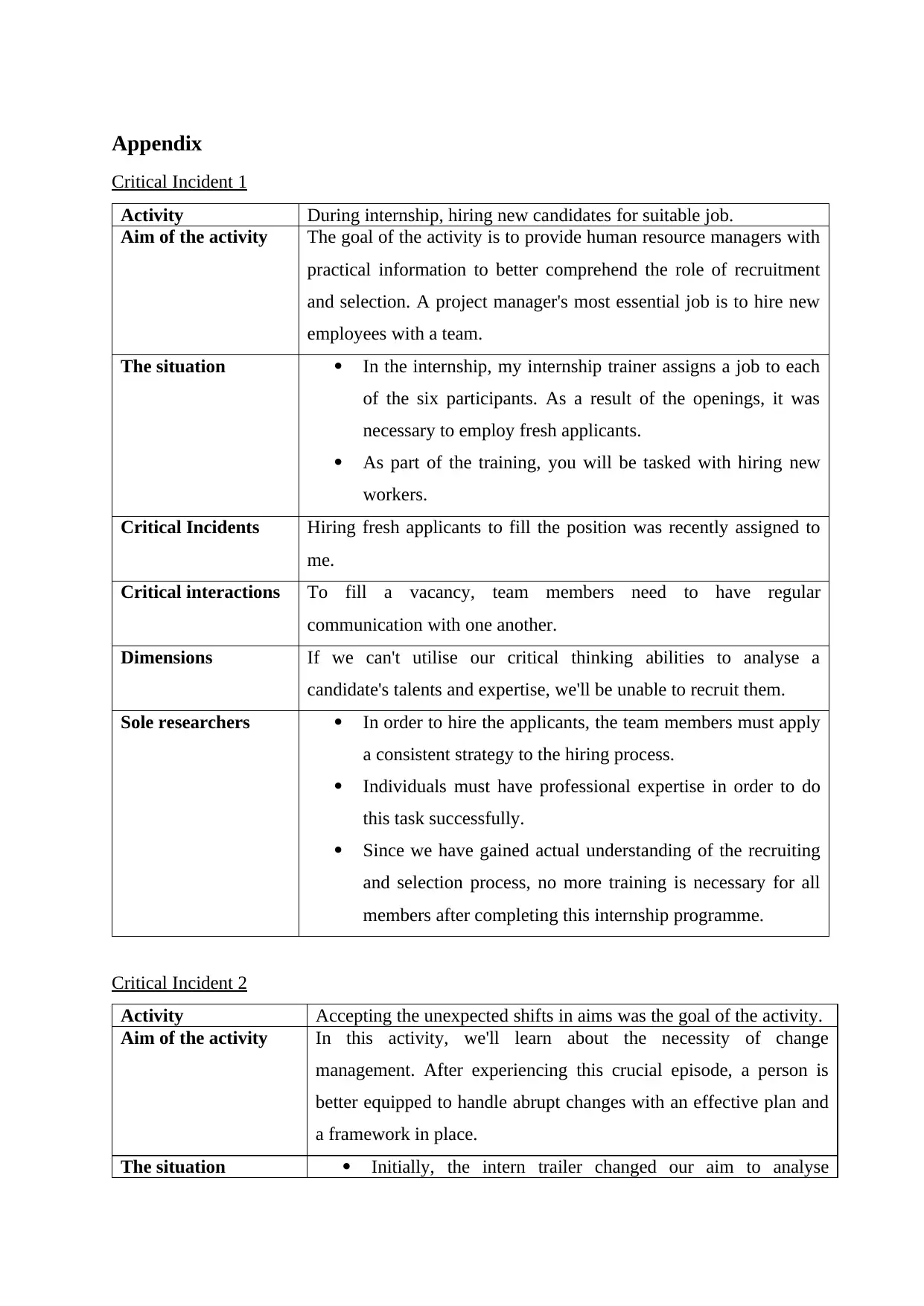
Appendix
Critical Incident 1
Activity During internship, hiring new candidates for suitable job.
Aim of the activity The goal of the activity is to provide human resource managers with
practical information to better comprehend the role of recruitment
and selection. A project manager's most essential job is to hire new
employees with a team.
The situation In the internship, my internship trainer assigns a job to each
of the six participants. As a result of the openings, it was
necessary to employ fresh applicants.
As part of the training, you will be tasked with hiring new
workers.
Critical Incidents Hiring fresh applicants to fill the position was recently assigned to
me.
Critical interactions To fill a vacancy, team members need to have regular
communication with one another.
Dimensions If we can't utilise our critical thinking abilities to analyse a
candidate's talents and expertise, we'll be unable to recruit them.
Sole researchers In order to hire the applicants, the team members must apply
a consistent strategy to the hiring process.
Individuals must have professional expertise in order to do
this task successfully.
Since we have gained actual understanding of the recruiting
and selection process, no more training is necessary for all
members after completing this internship programme.
Critical Incident 2
Activity Accepting the unexpected shifts in aims was the goal of the activity.
Aim of the activity In this activity, we'll learn about the necessity of change
management. After experiencing this crucial episode, a person is
better equipped to handle abrupt changes with an effective plan and
a framework in place.
The situation Initially, the intern trailer changed our aim to analyse
Critical Incident 1
Activity During internship, hiring new candidates for suitable job.
Aim of the activity The goal of the activity is to provide human resource managers with
practical information to better comprehend the role of recruitment
and selection. A project manager's most essential job is to hire new
employees with a team.
The situation In the internship, my internship trainer assigns a job to each
of the six participants. As a result of the openings, it was
necessary to employ fresh applicants.
As part of the training, you will be tasked with hiring new
workers.
Critical Incidents Hiring fresh applicants to fill the position was recently assigned to
me.
Critical interactions To fill a vacancy, team members need to have regular
communication with one another.
Dimensions If we can't utilise our critical thinking abilities to analyse a
candidate's talents and expertise, we'll be unable to recruit them.
Sole researchers In order to hire the applicants, the team members must apply
a consistent strategy to the hiring process.
Individuals must have professional expertise in order to do
this task successfully.
Since we have gained actual understanding of the recruiting
and selection process, no more training is necessary for all
members after completing this internship programme.
Critical Incident 2
Activity Accepting the unexpected shifts in aims was the goal of the activity.
Aim of the activity In this activity, we'll learn about the necessity of change
management. After experiencing this crucial episode, a person is
better equipped to handle abrupt changes with an effective plan and
a framework in place.
The situation Initially, the intern trailer changed our aim to analyse
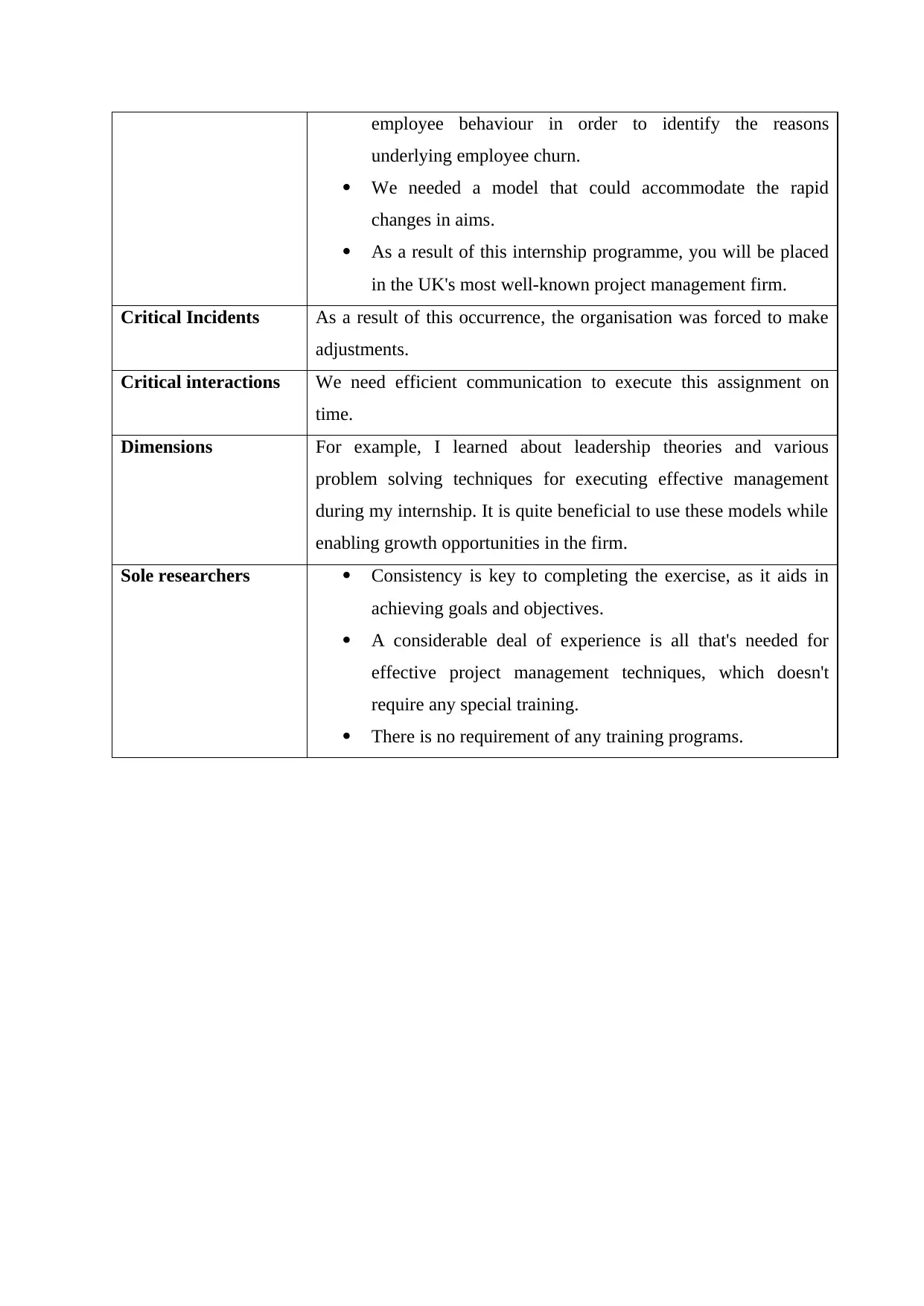
employee behaviour in order to identify the reasons
underlying employee churn.
We needed a model that could accommodate the rapid
changes in aims.
As a result of this internship programme, you will be placed
in the UK's most well-known project management firm.
Critical Incidents As a result of this occurrence, the organisation was forced to make
adjustments.
Critical interactions We need efficient communication to execute this assignment on
time.
Dimensions For example, I learned about leadership theories and various
problem solving techniques for executing effective management
during my internship. It is quite beneficial to use these models while
enabling growth opportunities in the firm.
Sole researchers Consistency is key to completing the exercise, as it aids in
achieving goals and objectives.
A considerable deal of experience is all that's needed for
effective project management techniques, which doesn't
require any special training.
There is no requirement of any training programs.
underlying employee churn.
We needed a model that could accommodate the rapid
changes in aims.
As a result of this internship programme, you will be placed
in the UK's most well-known project management firm.
Critical Incidents As a result of this occurrence, the organisation was forced to make
adjustments.
Critical interactions We need efficient communication to execute this assignment on
time.
Dimensions For example, I learned about leadership theories and various
problem solving techniques for executing effective management
during my internship. It is quite beneficial to use these models while
enabling growth opportunities in the firm.
Sole researchers Consistency is key to completing the exercise, as it aids in
achieving goals and objectives.
A considerable deal of experience is all that's needed for
effective project management techniques, which doesn't
require any special training.
There is no requirement of any training programs.
⊘ This is a preview!⊘
Do you want full access?
Subscribe today to unlock all pages.

Trusted by 1+ million students worldwide
1 out of 12
Related Documents
Your All-in-One AI-Powered Toolkit for Academic Success.
+13062052269
info@desklib.com
Available 24*7 on WhatsApp / Email
![[object Object]](/_next/static/media/star-bottom.7253800d.svg)
Unlock your academic potential
Copyright © 2020–2025 A2Z Services. All Rights Reserved. Developed and managed by ZUCOL.




